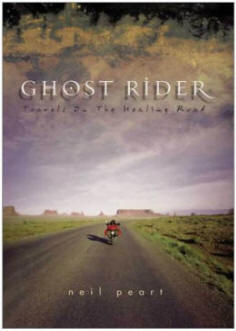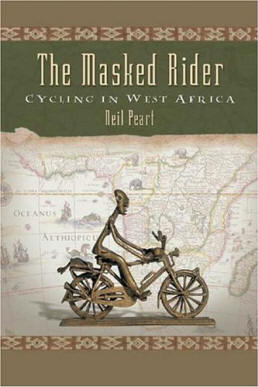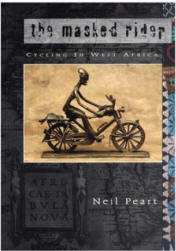Neil Peart ― Books
Neil Peart published his first non-fiction, public book in 1996, The Masked Rider, the story of his bicycle trip across Western Africa. Before that, he wrote many magazine articles, privately published books, and the introduction to most Rush tour books. Here are my reviews of his books:
Traveling Music: Playing Back the Soundtrack to My Life and Times

Product Details -
Hardcover
Hardcover: 440 pages
Publisher: ECW Press; (September 2004)
ISBN: 1550226649
Product Details -
Paperback
Paperback: 440 pages
Publisher: ECW Press; (September 2004)
ISBN: 1550226665
Distributed in the U.S. by Independent Publishers
Group
Distributed in Canada by Jaguar Book Group
www.ecwpress.com"
Traveling Music: Playing Back the Soundtrack to My Life and Times is a superb memoir of the most influential drummer of the past 30 years. Of his three published non-fiction books, this is his best book.
Neil uses the framework of a trip to Big Bend National Park in West Texas to write about the importance of music in his life―present, past, and future. We drive along with him in his BMW Z-8, listening to Frank Sinatra, Madonna, Pink Floyd, and many others. We get to hear about Neil's favorite musicians of all time and why.
The book's chapters are named after the different parts of a song: intro, verse, chorus, middle eight, and rideout. There are even lyrics to a song at the beginning called "Traveling Music" that serves as an epigraph for the entire book, and echo again in the different chapter headings. It begins like this:
Driving away to the east, and into the past
History recedes in my rear-view mirror
Carried on a wave of music down a desert road
Memory drumming at the heart of a factory town
The book travels in unexpected directions, which makes for a good read. Just when we think it's going to be a road book, we flash back into Neil's past. And just when we think it's going to be a memoir, it turns back into a road book. And when we think we have it all figured out, it turns into an African travelogue, or a Rush tour-log. Or Neil is telling us about how he wrote the book we're reading. At one point, he becomes a critic of the critics, talking about those who labeled Rush pretentious through all the years. He writes:
In an unfortunate contradiction, progressive music was described by ignorant, biased critics as 'pretentious,' but what a confused value system that terminology represented. Seldom was there a more honest style of music, based on solid principles of musicianship, exploration, and fascination.
Throughout the book, we come to understand that Neil is a big fan of music; but he listens to things you'd never expect, like 98-degrees and Frank Sinatra. And he always explains why he's listening to these bands, why they're important to him.
For the Rush fan, there are so many interesting stories in this book. There's a great passage about Neil preparing for the SARS concert in Toronto in 2003 and about how nerve-wracking the experience was for him. There's the constant refrain of "The Right Thing to Do" echoing through the book, a credo that Neil lives by. Does he want to tour? No, but it's "The Right Thing to Do."
At the end of this book, I came away with a new understanding of the man, Neil Peart, and how hard he's worked to get where he is. At one point, he writes, "I envy no man," and I can understand why. He is a living example of "seize the day," whether it's his constant reading, traveling, or learning. I'm just glad he decided to sit down and write another book.
Can't wait till the next one.
Read the "Traveling Music" playlist.

Ghost Rider: Travels on the Healing Road
Paperback: 400 pages
Publisher: ECW Press; (September 2002)
ISBN: 1550225480
In-Print Editions:
Hardcover
Ghost Rider: Travels on the Healing Road documents one man's terrible loss―a daughter, a wife―and then, ultimately, his recovery.
For someone so private, I found it a little odd that Peart wanted to share his personal nightmare. The first part of the book, where he recounts losing his family in a year, is shocking.
Then he sets out on the road on his BMW motorcycle to heal, to observe, to write letters to friends and family. In my first reading, I found the story―while interesting in a travelogue kind of way―to get bogged down in the repetition of grief, sorrow, and letters to his friend Brutus. (Brutus is supposed to join Neil on the road, but gets nabbed by police for trafficking some kind of illegal substance into the U.S.) About halfway through, I found myself flipping through the letters and racing toward the end.
Months later, a funny thing happened: I picked up Ghost Rider again to look for a particular section about Peart driving through the Tri-Cities, the place where I grew up (I think he calls it "outlet mall hell"). As I looked for this particular reference, I started reading different sections of the book, out of sequence. I was surprised how funny they were and how interesting the writing was. I started reading it aloud to my wife, who also started laughing. So, I kept the book by my bed and picked it up every so often, reading different passages.
Even though Ghost Rider is an uneven read, it does offer a portrait of a man during his darkest hour. The unevenness reflects the shape of grief on this scale: One day being okay, the next being almost unlivable. These same sentiments are echoed in the lyrics of "How It Is," from the Vapor Trails CD:
Here's a little trap
That sometimes catches everyone
When today's as far as we can see
Faith in bright tomorrows
giving way to resignation
That's how it is ― how it's going to be
"It's such a cloudy day
Seems we'll never see the sun
Or feel the day has possibilities
Frozen in the moment ―
the lack of imagination
Between how it is and how it ought to be
The Masked Rider
 Hardcover/Paperback: 260 pages
Hardcover/Paperback: 260 pages
Publisher: Ecw Press (September 28, 2004)
ISBN: 1550226673
In-Print Editions: Hardcover | Paperback |
Most Rush fans are keenly aware of Neil Peart's bicycle adventures. They know the journeys have influenced his drumming (the beat in "Heresy") and lyrics ("Tai Shan" on Hold Your Fire). They know Peart co-authored a short story about the bicyclist in Africa who finds a special drum, saw the Peart in the Counterparts tour book in front of "The Great Mosque" in Djenne, and heard rumors about books he wrote for friends (Raindance Over the Rockies).
I was one of those fans, and to say I was excited about The Masked Rider: Cycling in West Africa is an understatement. Finally, I got to read about those adventures!
Everything about the book reminds me of the precision and attention to detail that defines Peart in his artistic pursuits. The graphic design is impeccable. For example, the cover is beautifully designed by Hugh Syme, artist of every Rush album since Caress of Steel. The writing is finely crafted and controlled, like Neil's drum parts.
The story about a famous musician taking the road less traveled is an interesting one, and some of the more telling moments are of Peart interacting with his cycling "family." He seems drawn to some of them (Leon), while abhorring others (I'm think of Elsa, the woman who got more than she bargained for on this African journey). We get to understand, even more than in his later book, Ghost Rider, what makes this man tick. Peart is open to the possibilities on a difficult road, whether it's visiting a church (he's a self-proclaimed atheist) or trying to negotiate with a drunk border guard waving a gun in his face.
My favorite moment in the book is when a native hears about a rock star in town and approaches Peart about how he can become a famous rock star. Peart asks if the man plays an instrument, to which the man answers, "No." Peart talks to him about learning an instrument, about perseverance, about what it really takes to make it. The man is crestfallen.
In many ways, I like this book more than Ghost Rider. The subject matter is less volatile (how could it not be?), and I have a personal interest in other cultures and travel. So I recommend this book to Rush fans (although there aren't as many revelations about Rush) and travel fans.
Pottersfield Press Edition of The Masked Rider
The Masked Rider was originally published by Pottersfield Press. This edition is now out of print.

Paperback: 288 pages
Publisher: Pottersfield Pr; (1999)
ISBN: 1895900026
Privately-Published Books (out of print)
The Orient Express
Note: The titles of these books are taken from "Traveling Music": page 342

Drum Techniques of Rush
Paperback: Dimensions (in inches): 0.25 x 12.00 x 9.00
Publisher: Warner Brothers Publications; (March 1, 1985)
ISBN: 0769250556
I picked up this book when I was 16 or 17, and I couldn't believe my good fortune. Here were transcriptions for many of the Rush songs I was trying to learn! Many "secrets" of Neil's technique are revealed in this book. I never could read music very well, but I could understand it enough to decode some of these intricate drum parts.
Included in this book are transcriptions for:
Between the Wheels
Distant Early Warning
Freewill
Jacob's Ladder
La Villa Strangiato
Limelight
Natural Science
New World Man
Red Barchetta
The Spirit of Radio
Subdivisions
The Trees
Tom Sawyer
Xanadu
YYZ